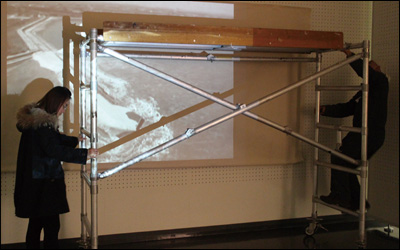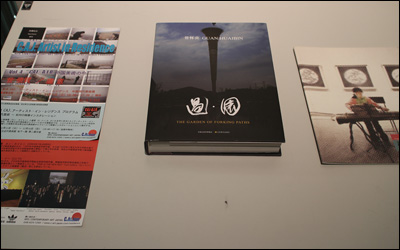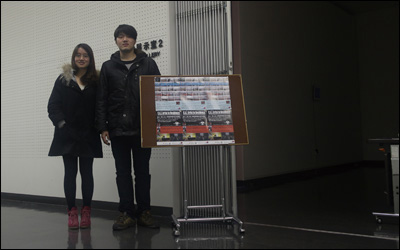





Eastern Light - Guan Huai Bin and Lu Yi
Guan Huai Bin creates his art works in various styles such as installations, film, images, field sculptures, and physical expression. At the same time, he deals with various materials; wooden shutters of folk dwellings and Chinese garden rocks that remind us of Chinese traditional culture, steel plates from industrial materials, and ready-made products found in our daily lives, such as newspapers and thermos bottles. Using various materials in a complex way, he creates his one world view in his works. The most important element featured in his works is “light”. Light does not take on a role that can be spoken of in line with other materials. It is a material that integrates all styles and materials and determines the worldview depicted in his works.
In “Landscape painting” (1949), Kenneth Clark said that the most important element in landscape painting which reached its completion in 17th century Flandre, Holland is the effect of light integrating the entire picture. No matter how much you depict the objects, the world of the painting would not come into effect without light.
The Chinese have attempted to depict landscapes via light from long ago. Ink paintings which are said to have been completed in the Tang period (8th century) reduced the various colors of nature to monochrome and tried to represent the universe via the contrast of light and shadow. The light used by Guan seems to follow this history.
Of course, this does not mean that Guan is a traditionalist. As a matter of fact, his styles and activities are part of the stream of international contemporary art. Perhaps the situation is quite the opposite. He became conscious of the past when he locked his sights on contemporary art. In the non-western world where modernization came from outside, modernization directly meant westernization. The world we live in is an extension of that. It is when we step out of the culture we belong to that we clearly realize that the traditions and modernity of both the East and West are entangled in our reality.
In this exhibition, Guan exhibited works realized by “light”. “The Ray of Light” filmed a performance that slit up a blackout curtain and the light streaming in from behind the curtain. “Rockery Light” filmed the natural stones in a garden and used CG animation to make the stones flicker. “2007・1/6”, which filmed scenes of a wreck, and “Back Flaw”, which dealt with the tidal bore of the Qiantang River, are spectacles in monochrome which also make us recall the expressions in ink painting. He edited these works to control the speed of time to derive aspects where reality and fiction are mixed.
Lu Yi, an artist who is one generation younger than Guan exhibited three works with a different tone; “Above Paradise”, a documentary film about environmental problems, “True, False”, a film that expressed his own interpretation of the world, and “Hormone Mist”, the most notable work. In the third work, a man wearing burning clothes runs over the bridge spanning a quiet lake emitting thick smoke from his back. The smoke filling the screen and the humid air of the lake convey a dense atmosphere like a Nansong ink painting. Here we can see Lu’s expression of “light”, which has something in common with that of Guan.
Perhaps my view is biased and interprets them too much in line with Chinese traditions. In fact, these works may be the output of the artists' nature and were not strongly intended to express what I have written here. However, that is all right for the starting point of our communication, since I can only see their works as someone who was born and raised in the Japan of today. We can start from acknowledging the gap between us.
Once there was a time that western modernism, a local value, was regarded as universal. If someone could not conform to this value, they were removed because of their differences. We have to be free from this exclusive value, acknowledge the difference between cultures, and start communication. The significance and possibility of the artist in residence program lies here.















